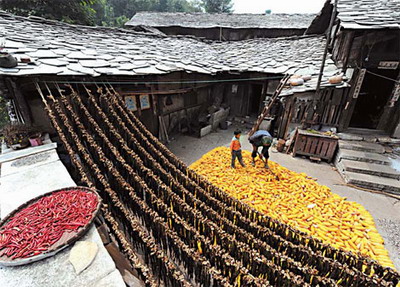
|
BIZCHINA> Review & Analysis
 |
|
Bridging the urban and rural gap
By Fu Jing (China Daily)
Updated: 2008-11-10 16:29
 At a time when the global financial meltdown and looming recession are capturing the world's attention, some have wondered why China's highest leadership still places rural development high on its work agenda by convening a close-door plenary among top decision-makers in October.
It's simple, really. Before the financial tsunami, food shortages, grain price hikes and starvation were plaguing the world and continue to do so. And the World Bank recently estimated that an additional 100 million people outside China have fallen into poverty because of rising food and energy prices. Meanwhile, December sees China's 30th anniversary of reform and opening up and the central government believes it's time to design a roadmap for farmers to equally benefit from economic prosperity as their urban counterparts. The worsening world economy is also forcing China to change its export-dependent model and tap the potential of vast rural regions in an effort to sustain three decades of growth. Against the backdrop, the 3rd plenum of the 17th Central Committee of the Communist Party of China (CPC) on October 9-12 decided to respond swiftly to protect arable land, rekindle farmers' passion for planting crops, ensure self-sufficiency in grain supplies, bridge the rural-urban gap and push forward grassroots democracy. "This is a policy stone from the highest leadership that is expected to kill several birds at the same time," Vice-Premier Hui Liangyu told a recent meeting. As crises and uncertainties at home and abroad arrive in droves, Hui says, "We must bear in mind that agricultural harvests and rural stability are the base for us to cushion against external impacts." Hui and the leadership are wise to safeguard the bottom line. Last year, the total volume of global grain trade reached 250 million tons, nearly amounting for 40 percent of China's grain consumption. This means any increase of grain imports by China may cause global grain price fluctuations. However, China has implemented a self-sufficiency policy for years with its grain yield exceeding 500 million tons last year after five consecutive harvests, and now it only imports 5-percent of grains it consumes. To balance grain trade, China also exported about 20 million tons of grains in 2007. In face of its growing population, dwindling arable land and water supplies and climate change, the State Council has already approved a plan prior to the CPC's October plenary that the country would be 95 percent grain self-sufficient over the next 12 years. In order to do so, the country should maintain a grain yield of 500 million tons by 2010 and reach 540 million tons by 2020, when the population is likely to hit 1.36 billion and 1.45 billion respectively. The biggest challenge for the government is to find a solution to stop urban sprawl from seizing more arable land, says Lu Mai, secretary-general of China Development Research Foundation, a think-tank organization during a recent interview with China Business Weekly. He urges efforts to ensure a minimum of 120 million hectares of arable land by 2020 and says the agriculture infrastructure and water facilities should also be improved. (For more biz stories, please visit Industries)
|
||||